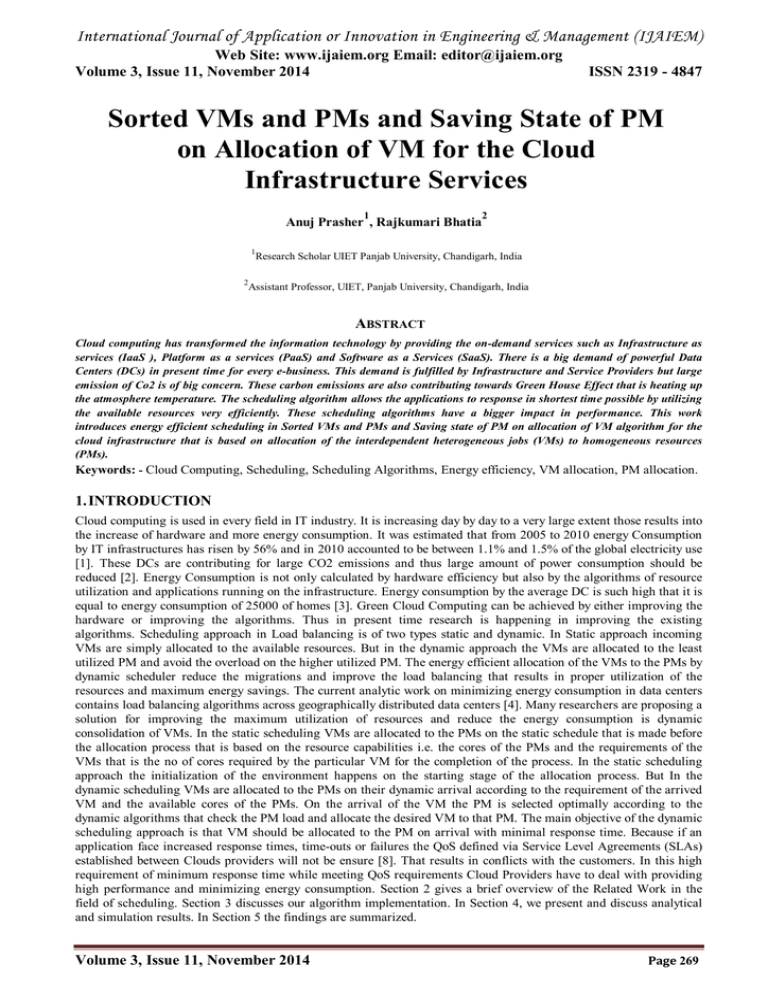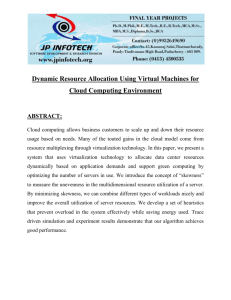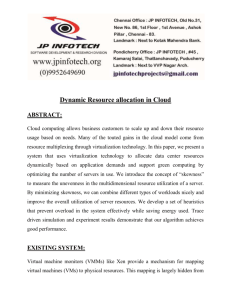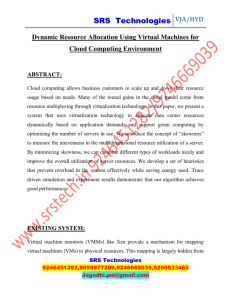Sorted VMs and PMs and Saving State of PM
advertisement

International Journal of Application or Innovation in Engineering & Management (IJAIEM) Web Site: www.ijaiem.org Email: editor@ijaiem.org Volume 3, Issue 11, November 2014 ISSN 2319 - 4847 Sorted VMs and PMs and Saving State of PM on Allocation of VM for the Cloud Infrastructure Services 1 Anuj Prasher , Rajkumari Bhatia 1 2 2 Research Scholar UIET Panjab University, Chandigarh, India Assistant Professor, UIET, Panjab University, Chandigarh, India ABSTRACT Cloud computing has transformed the information technology by providing the on-demand services such as Infrastructure as services (IaaS ), Platform as a services (PaaS) and Software as a Services (SaaS). There is a big demand of powerful Data Centers (DCs) in present time for every e-business. This demand is fulfilled by Infrastructure and Service Providers but large emission of Co2 is of big concern. These carbon emissions are also contributing towards Green House Effect that is heating up the atmosphere temperature. The scheduling algorithm allows the applications to response in shortest time possible by utilizing the available resources very efficiently. These scheduling algorithms have a bigger impact in performance. This work introduces energy efficient scheduling in Sorted VMs and PMs and Saving state of PM on allocation of VM algorithm for the cloud infrastructure that is based on allocation of the interdependent heterogeneous jobs (VMs) to homogeneous resources (PMs). Keywords: - Cloud Computing, Scheduling, Scheduling Algorithms, Energy efficiency, VM allocation, PM allocation. 1. INTRODUCTION Cloud computing is used in every field in IT industry. It is increasing day by day to a very large extent those results into the increase of hardware and more energy consumption. It was estimated that from 2005 to 2010 energy Consumption by IT infrastructures has risen by 56% and in 2010 accounted to be between 1.1% and 1.5% of the global electricity use [1]. These DCs are contributing for large CO2 emissions and thus large amount of power consumption should be reduced [2]. Energy Consumption is not only calculated by hardware efficiency but also by the algorithms of resource utilization and applications running on the infrastructure. Energy consumption by the average DC is such high that it is equal to energy consumption of 25000 of homes [3]. Green Cloud Computing can be achieved by either improving the hardware or improving the algorithms. Thus in present time research is happening in improving the existing algorithms. Scheduling approach in Load balancing is of two types static and dynamic. In Static approach incoming VMs are simply allocated to the available resources. But in the dynamic approach the VMs are allocated to the least utilized PM and avoid the overload on the higher utilized PM. The energy efficient allocation of the VMs to the PMs by dynamic scheduler reduce the migrations and improve the load balancing that results in proper utilization of the resources and maximum energy savings. The current analytic work on minimizing energy consumption in data centers contains load balancing algorithms across geographically distributed data centers [4]. Many researchers are proposing a solution for improving the maximum utilization of resources and reduce the energy consumption is dynamic consolidation of VMs. In the static scheduling VMs are allocated to the PMs on the static schedule that is made before the allocation process that is based on the resource capabilities i.e. the cores of the PMs and the requirements of the VMs that is the no of cores required by the particular VM for the completion of the process. In the static scheduling approach the initialization of the environment happens on the starting stage of the allocation process. But In the dynamic scheduling VMs are allocated to the PMs on their dynamic arrival according to the requirement of the arrived VM and the available cores of the PMs. On the arrival of the VM the PM is selected optimally according to the dynamic algorithms that check the PM load and allocate the desired VM to that PM. The main objective of the dynamic scheduling approach is that VM should be allocated to the PM on arrival with minimal response time. Because if an application face increased response times, time-outs or failures the QoS defined via Service Level Agreements (SLAs) established between Clouds providers will not be ensure [8]. That results in conflicts with the customers. In this high requirement of minimum response time while meeting QoS requirements Cloud Providers have to deal with providing high performance and minimizing energy consumption. Section 2 gives a brief overview of the Related Work in the field of scheduling. Section 3 discusses our algorithm implementation. In Section 4, we present and discuss analytical and simulation results. In Section 5 the findings are summarized. Volume 3, Issue 11, November 2014 Page 269 International Journal of Application or Innovation in Engineering & Management (IJAIEM) Web Site: www.ijaiem.org Email: editor@ijaiem.org Volume 3, Issue 11, November 2014 ISSN 2319 - 4847 2. RELATED WORKS There is vast research that is happening on scheduling for the cloud environment. But still energy savings are on high priority and various algorithms are achieving that. Few scheduling algorithms are discussed below. 2.1 Exact VM Allocation Algorithm In this algorithm extended Bin-Packing approach is used. In this author includes valid conditions in form of constraints and equalities in the algorithm [6]. In this optimization is achieved by inclusion of valid constraints. 1) Power capacity of a server cannot exceed from maximum power. 2) When a server is not running any job should be switched off. 2.2 FCFS Algorithm In First Come first Serve Scheduling Algorithm the VMs are allocated to the PMs in first come first serve bases. In this approach following are constraints that are considered during the scheduling. 1) The VM that is arrived first is allocated to PM. In this scheduling the response time to allocate the VM is very less. 2) But in this scheduling power consumption is large because the VM that require less PM with less core capacity is sometime allocated to the PM that have large core capacity thus leads to waste of power. 3) This approach is used at very places but energy consumption is not minimized. 2.3 Custom Round Robin Algorithm In this algorithm round robin approach is used. In this approach the VMs are allocated to the PMs in round robin fashion. In this optimization and load balancing is achieved by inclusion of valid constraints. 1) In this approach load balancing is done by allocated VM to a PM in circular fashion. First VM is allocated to first PM and second VM is allocated to second PM and this process continues until all the VMs are not allocated. 2) In this approach the VMs are allocated in circular fashion and load balancing is achieved, but VMs are not in any order so in some cases VM that require less PM with less core capacity is sometime allocated to the PM that have large core capacity. In some cases if a VM required large no of cores then it take time to allocate to PM that matches to its capacity. 3.SORTED VMS AND PMS The Sorted VMs and PMs Works in two modules. These modules works together optimize the scheduling. 1) In the first module VMs allocation to PMs is done. 2) In second module a check is applied on the running of PMs. These modules are explained in detail. The first module responsibility is to find the most suitable PM and assign the VMs to PMs using the requirements of the VMs and the capacity of the PMs. In this module we first sort all the VMs and PMs according to their requirements and capacities. VMs are arranged in the decreasing order of the processing requirements and PMs are arranged in decreasing order of their capacity. In second module there is a Resource monitor whose responsibility is to communicate with all the PM’s resource prober. It collects the PM remaining capabilities and checks the current load on each PM. It also monitors the number of VMs in execution/waiting queues in each PM to decide the appropriate PM to the VMs. 3.1 System Architecture In A Cloud we can have n number of Data centers that are present in the different regions of the geographical locations (Figure 1). But, in this experiment setup only a single data center with multiple PMs having multiple no of VMs allocated on it is considered. Virtualization is the main technology for cloud computing [7]. With Virtualization we generalize the cloud infrastructure. 3.2 Scheduling in the Sorted VMs and PMs Scheduling of Sorted VMs and PMs basically find the most suitable PM and assign the VMs to PMs using the requirements of the VMs and the capacity of the PMs. First we sort all the VMs and PMs according to their requirements and capacities. VMs are arranged in the decreasing order of the processing requirements and PMs are arranged in decreasing order of their capacity. Figure1: System Architecture Volume 3, Issue 11, November 2014 Page 270 International Journal of Application or Innovation in Engineering & Management (IJAIEM) Web Site: www.ijaiem.org Email: editor@ijaiem.org Volume 3, Issue 11, November 2014 ISSN 2319 - 4847 VMs are allocated to PMs in Circular Round Robin Fashion but on each allocation state of PM are saved and in next allocation saved PM capacity are checked. The control flow is shown in figure 2. 3.2 Scheduler in The Sorted VMs and PMs Figure 2: Flow Chart of Scheduler in the Sorted VMs and PMs 4. EXPERIMENT & RESULTS The performance of the Sorted VMs and PMs Algorithm has been examined based on the results of simulation done using the c# .net. In the following illustrations, the response time is examined in the FCFS, Round Robin, and The Sorted VMs and PMs under the different load conditions and resource conditions. Visual Studio is used for simulation. 4.1 Comparison of Overall Energy Consumption Table 1. Energy Consumption (KW) Volume 3, Issue 11, November 2014 Page 271 International Journal of Application or Innovation in Engineering & Management (IJAIEM) Web Site: www.ijaiem.org Email: editor@ijaiem.org Volume 3, Issue 11, November 2014 ISSN 2319 - 4847 Machines) Conditions and varied load conditions. The first column of table tells the serial number. The Second column represents the number of requested VMs. Third column depicts the average energy (in kW) consumed by the VMs’ allocation computed by the FCFS algorithm. Fourth column depicts the average energy (in kW) consumed by the VMs’ allocation computed by the CRR algorithm. Finally, the last column depicts the average energy (in kW) consumed by the VMs’ allocation computed by proposed algorithm. As it can be observed, FCFS and CRR algorithm consumed more energy than the proposed algorithm. We can observe that proposed algorithms save important energy consumption regarding FCFS and CRR Algorithm. Figure 3: Energy (KW) Consumption of three algorithms comparison Figure 3 is the graph that is showing the energy consumption (KW) of the three algorithms. In the following figure the x-axis is depicting the no of VMs and y-axis is depicting the Energy Consumption in KW. Energy consumption of the three algorithms is shown by three different lines. FCFS algorithm has maximum energy consumption and that is depicted by the line that is above from other two lines. CRR algorithm has less energy consumption than the FCFS algorithm but has more energy consumption than the poposed algorithm and that is depicted by the middle line in the graph. Proposed algorithm has less energy consumption than the two algorithms and it is depicted by the bottom line in the graph. Figure 4: Energy Savings by proposed algorithm on comparing with Custom Round Robin Volume 3, Issue 11, November 2014 Page 272 International Journal of Application or Innovation in Engineering & Management (IJAIEM) Web Site: www.ijaiem.org Email: editor@ijaiem.org Volume 3, Issue 11, November 2014 ISSN 2319 - 4847 In the figure 4 energy savings of the proposed algorithm is depicted when compared to the CRR algorithm. In the following figure the x-axis is depicting the no of VMs and y-axis is depicting the Energy Savings in KW. In this figure it is cleared that the proposed algorithm is saving energy than the CRR algorithm at different loads. At the different loads in the simulation maximum energy saved by the proposed algorithm is 15 KW. Figure 5: Energy Savings by proposed algorithm on comparing with First Come First Serve In the figure5.3 energy savings of the proposed algorithm is depicted when compared to the FCFS algorithm. In the following figure the x-axis is depicting the no of VMs and y-axis is depicting the Energy Savings in KW. In this figure it is cleared that the proposed algorithm is saving energy than the FCFS algorithm at different loads. At the different loads in the simulation maximum energy saved by the proposed algorithm around is 34 KW. 4.2 Analysis The following is the descending order performance of the algorithms in the provided heterogeneous environment. • Sorted VMs and PMs • Round Robin • FCFS Table 1 and figure 3 shows the energy consumption in KWs for various Algorithms using different number of Virtual Machines at a time. The individual energy savings on comparison with FCFS shown in figure 4 and with CRR is shown in figure 5.This result proved that the Sorted VMs and PMs Delivers a faster completion time than the other two scheduling algorithms (Round Robin and FCFS). The Sorted VMs and PMs Scheduler algorithm considers the requirement of cores of VMs along with processing capacity of the PMs to assign the VM. So, the large cores VMs get assigned to the higher capacity PMs. This helps in to complete the VMs allocation in a shorter time. It also considers the load of all its configured PMs by checking the remaining capacity. On every VM allocation state of the PM is saved and when next VM has to allocate the PM whose state is saved is checked with capacity and allocation is done. If in case that PM has low capacity than the arrived VM requirement then the next PMs are checked and when the PM with higher capacity is found arrived VM is allocated to that PM and its state is saved for the next VM allocation. This process continuous till all the VMs are allocated to the PMs. So this algorithm is most suitable to the heterogeneous environment data centers. 5. CONCLUSION & FUTURE WORK In this work, Sorted VMs and PMs Algorithm consider the capabilities of each PM and requirement of each requested VM to assign the VM into the most appropriate PMs. Sorted VMs and PMs saves the state of the PM on allocation of VM so there is no need to go to the first PM for to check the remaining capacity for allocation this saves the response time for allocation and as well as this balance the load on all PM and make the scheduling optimal than the other two algorithms. In this algorithm the allocation is done in circular round robin fashion but with saving the state of PM who has allotted the last VM and on arrival of next VM capacity check starts from that saved state PM, that minimize the response time for allocation of VM .This algorithm provides load balancing and saves energy by reducing the response time for allocation of VM. For future work this algorithm can be extended further to schedule the load balancing of big scenarios for the VM migrations. Volume 3, Issue 11, November 2014 Page 273 International Journal of Application or Innovation in Engineering & Management (IJAIEM) Web Site: www.ijaiem.org Email: editor@ijaiem.org Volume 3, Issue 11, November 2014 ISSN 2319 - 4847 REFERENCES [1] “Growth in data center electricity use 2005 to 2010,” Analytics Press, Tech.Rep., 2011. [2] Anubha jain, Manoj Mishra, Sateesh Kumar Peddoju and Nitin jain, “Energy efficient comuting-green cloud computing”, International Conference on Energy Efficient Technologies for Sustainability (ICEETS), pp. 978-982, April 2013. [3] Gartner report, financial times, 2007. [4] R.Yamini, “Power management in cloud comuting using green algorithm”, IEEE-International Conference On Advances In Engineering,Science And Management(ICAESM), pp. 128-133, March 2012. [5] M. Lin, Z. Liu, A. Wierman, and L. L. H. Andrew, “Online algorithms for geographical load balancing,” in Proceedings of the 3rd International Green Computing Conference (IGCC), pp. 1–10., 2012. [6] Chaima Ghribi, Makhlof Hadiji and Djamal Zeghlache, “Energy efficient VM scheduling for cloud data centers: exact allocation and migration algorithms”, in 13th IEEE/ACM International Symposium on Cluster, Cloud, and Grid Computing (CCGrid) pp.671-678, May 2013. [7] Mohammad H., AL Shyaeji and M.D.Samrajesh, “An energy-aware virtual machine algorithm”, International Conference on Advances in Computing and Communication(ICACC), pp. 242-246, Aug. 2012. [8] http://en.wikipedia.org/wiki/Service-level_agreement. [9] A. Beloglazov, “Scripts for setting up and analyzing results of experiments using OpenStack Neat,” (accessed on 26/11/2012). [Online]. Available: http://github.com/beloglazov/spe-2012-experiments. [10] A. Beloglazov, J. Abawajy, and R. Buyya, “Energy-aware resource allocation heuristics for efficient management of data centers for Cloud computing,” Future Generation Computer Systems (FGCS), vol. 28, no. 5, pp. 755–768, 2011. [11] J. Baker, C. Bond, J. Corbett, J.J. Furman, A. Khorlin, J. Larsonand, J.M. Leon, Y. Li, A. Lloyd, and V. Yushprakh, “Megastore: Providing Scalable, Highly Available Storage for Interactive Services,” Proc. Conf. Innovative Data Systems Research (CIDR), pp. 223-234, Jan. 2011. [12] J. M. Tirado, D. Higuero, F. Isaila, and J. Carretero, “ Predictive data grouping and placement for cloud-based elastic server infrastructures” In 11th IEEE/ACM International Symposium on Cluster, Cloud and Grid Computing, Newport Beach, CA, USA, pp. 285-294, May 2011.. [13] Ye, D. Huang, X. Jiang, H. Chen, and S. Wu, “Virtual machine based energy-efficient data center architecture for cloud computing: a performance perspective”, in Proceedings of the IEEE/ACM International Conference on Green Computing and Communications, pp. 171–178, Dec. 2010. [14] Cesar O. Diaz, Harold Castro, Mario Villamizar, Johnatan E. Pecero and Pascal Bouvry, “ Energy-aware VM allocation on an opportunistic cloud infrastructure”, in 13th IEEE/ACM International Symposium on Cluster, Cloud, and Grid Computing (CCGrid), pp. 663-670, may 2013 [15] Ching-Chi Lin, Anton Beloglazov and Rajkumar Buyya, “Energy efficient allocation of virtual machines in cloud data centers”, in Proceedings of the IEEE/ACM International Conference on Cluster, Cloud and Grid Computing (CCGRID), pp. 577–578, may 2010 [16] Wei Huang, Xin Li, Zhuzhong Qian, “ An energy efficient virtual machine placement algorithm with balanced resource utilization”, 2013 Seventh International Conference on Innovative Mobile and Internet Services in Ubiquitous Computing, pp. 313-319, july 2013. [17] E. Feller, L. Rilling, and C. Morin, “Snooze: A scalable and autonomic virtual machine management framework for private Clouds,” in Proceedings of the 12th IEEE/ACM International Symposium on Cluster, Cloud and Grid Computing (CCGrid), 2012, pp. 482–489. [18] G. Dhiman, K. Mihic, and T. Rosing, “A system for online power prediction in virtualized environments using gaussian mixture models,” in Proceedings of the 47th Annual ACM/IEEE Design Automation Conference (DAC), 2010, pp. 807–812. [19] M. Cardosa, M. Korupolu, and A. Singh, “Shares and utilities based power consolidation in virtualized server environments,” in Proceedings of the 11th IFIP/IEEE International Symposium on Integrated Network Management (IM), 2009, pp. 327–334. [20] N. Bobroff, A. Kochut, and K. Beaty, “Dynamic placement of virtual machines for managing SLA violations,” in Proceedings of the 10th IFIP/IEEE International Symposium on Integrated Network Management (IM), 2007, pp. 119–128. AUTHOR Anuj Prasher received the B. Tech. degree in Computer Science Engineering from Lovely Professional University in 2012 and pursuing M. Tech. from Panjab University Chandigarh respectively. Volume 3, Issue 11, November 2014 Page 274





